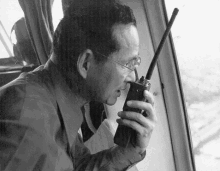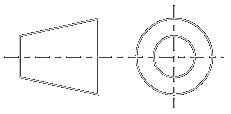Categories
- Hua Hin Weather Station 🌤
- Projects (Antiques) 🦖
- Micro Projects • Tools 🪓
- Atmega8 LED Panelmeter (U,I,°C,°F)
- Corona Customer Counter for a shop/place
- LCD Adapter • Interface
- Microphone Preamplifier
- ROTARY ENCODER (STEC11B03)
- SDRSharp and a DVB-T stick : a 20 EUR Spectrum Analyser ?
- UART - RS232 Bridge (ST232CDR)
- UART - USB Bridge (MCP2200)
- UART - ETHERNET Bridge (LANTRONIX XPORT)
- USB - InfraRed Transceiver
- USB - PLL / DDS - Interface
- Arduino Projects e.a. 🛸
- Spectrum Analyzer • Measurement Receiver
- A DC-199 MHz Spectrum Analyser 'VISIONARY' with Si4432
- A 15-2700 MHz Spectrum Analyser with the RF Explorer 3G+
- Levelmod - A DC to Daylight Microwave Powermeter
- Micro Smart Power Sensor - with AD8319, TMP101
- Polarmod - An I-Q-Processor with the AD9958
- VHF Airband Receiver with Si570 and AD8361
- Wacharamod - An FM Stereo Receiver with the TEA5767
- Wanmod, A Frequency Selective Levelmeter, 29.999 MHz
- Network Analyzer
- Frequency Counter • Frequency Standard
- Low Frequency (AF) Generators
- High Frequency (RF) Synthesizer
- Kumod - 1 MHz ... 200 MHz Synthesiser with the AD9958
- Micromod - A 220 MHz Synthesizer with the Si570
- Macromod - A 850 MHz Synthesizer with the LMK61E2
- Ningmod - A RF Synthesizer with the AD9953 + co-workers
- Sathanimod - an FM Radiostation with the Si4713
- Supermod - A 23.5 - 6000 MHz Synthesizer with the MAX2871
- Teramod - A 2 to 15 GHz Synthesizer
- Ultramod - A 9.9 - 3200 MHz Synthesizer with the Si564
- Power Supplies • Voltage Standards
- Measurement Devices • U • I • P • R • T
- RF Switches • Attenuators
- Component Tester
- P-I-D and other Controllers
- What's All This '...mod' Stuff, Anyhow ?
- Additional Components for all '...mod' things
- Other Shields for Arduino
- Shield BHUMI : A Voltage Standard, programmeable
- CALC-DUINO, a simple Pocket Calculator Shield (MAX7219)
- CLOCK-DUINO, a clock, to be shown to my teachers :-)
- DCF-77 Synthesizer. With Arduino. Aka "TimeDuino"
- Shield LEO : SMS on Power down
- Shield NRVD : Dual UHF Power Meter
- Shield MARCELLA : Control your Laboratory Devices
- Shield RENÉ : Reference Voltage Source, aka REFDUINO
- Shield TANACHAI : A Transistor Curve Tracer
- Shield TOBI : A 60 MHz, 80dB Scalar Network Ananlyzer
- Add-on BRUNO : Universal Battery Tester (Charge/Discharge)
- Arduino Final Projects : IPA's
- Arduino Knowledgebase
- Spectrum Analyzer • Measurement Receiver
- Bluepill • Blackpill Projects 🛸
- Teensy Projects 🛸
- Raspberry Pi Projects 🛸
- Python Lab Experiments 🐍
- Basics like e.g. 'Hello Arduino' e.a.
- Long Term Datalogging to File (Wanmod)
- VCO Testbench (Supplymod, Levelmod, Countermod)
- Amplitude Response 10.7 MHz Bandpass (Ningmod, Wanmod)
- Frequency Spectrum HF-Bands (Wanmod)
- EMC Precompliance Testing (conducted, Wanmod)
- EMC Precompliance Testing (far field, Wanmod)
- EMC Precompliance Testing (near field, R&S FSP)
- Diode Characteristics (2 x Rigol DM3058E, Supplymod)
- Python 3.x and PicoScope™
- Cookies • Breadcrumbs
- Power Supplies • Calculations
- Artificial Ground
- Power Supply Characterisation
- Power Supply Designer : Rectification
- Power Supply Designer : Linear Regulator
- Power Supply Gallery (Experience Database)
- Power Supply Ripple and Noise Measurements
- Yet another LM317 Calculator
- Feedback Voltage Divider Finder (LM2576 e.a.)
- High Voltage Power Supply (MC34063, step-up)
- Low Voltage Power Supply (MC34063, step-down)
- VB 408 Replacement
- Leomod, Power Supply for ±15 V, 1 A
- Powermod, a Power Supply with the LM317/LM337
- Samroimod - A 32 V / 1 A Power Supply
- Sungmod - A 270 V / 1 mA Power Supply
- Supplymod - A 20 V / 2 A Power Supply
- Thormod, a Power Supply for Photodiodes
- PETH-6 Power Supply • ± 15 V, 100 mA
- PETH-6 Power Supply • +7.5 V, for Arduino / Genuino
- PETH-20 Power Supply • ± 15 V, 600 mA
- PETH-30 Power Supply
- PETH-40 B3 Power Supply ±15V, 1200 mA
- PETH-40-HAM Power Supply • ± 15 V, 1.5 A
- PETH-49 Power Supply • 1 ... 19 V, 2 A
- PETH-200V - High Voltage Poweer Supply
- PETH-581 Power Supply • Buck Conv. with Linear Afterburner
- PETH-1074 Power Supply • Step-Down with an LT1074
- PETH-8093 Power Supply • Step-Down and linear regulation
- PETH-9910 Power Supply • 8 ... 16 V, 10 A
- Amplifiers • Calculations
- BJT Buffer Amplifier Designer (Collector Feedback Bias)
- BJT Buffer Amplifier Designer (Base Bias Network)
- BJT Buffer Amplifier Designer (Voltage Feedback Bias)
- BJT Buffer Amplifier Designer (Emitter Feedback Bias)
- Broadband VHF Power Amplifier, 3 ... 540 MHz, 1.5 W
- Broadband UHF Preamplifier, > 3 GHz, 20 dB, NF 2.4 dB
- Broadband UHF Amplifier "BONLab-81", 10 dB, +19 dBm
- Broadband Measurement Amplifier, +13 dBm, 4 GHz
- Broadband Power Amplifier, 1 Watt from 2 - 2500 MHz
- Broadband LNA with the QPL9547 - 100 MHz ... 6 GHz
- Broadband LNA with the BGA2817 - DC ... 2 GHz, 5 dBm
- VHF Power Amplifier with the M57762 - 1.2 ... 1.35 GHz, 1 W+
- VHF Power Amplifier with the TAT8888 - 50 ... 1000 MHz, 1 W
- VHF Power Amplifier with the RFPD3580 - 45 ... 1218 MHz, 5 W
- MAR, ERA, GALI Amplifier Bias Calculator
- Measurement Amplifier with the LMH6609 • Vu = 1000, 30 MHz
- Shortwave Amplifier with 2 x 2N2219A - 0.1 ... 50 MHz, 22 dB
- Shortwave Power Amplifier with MRF101 - 0.1 ... 50 MHz, 18 dB
- Sojamod, a 20 dB RF Amplifier up to more than 1.5 GHz
- Sojamod-AF, a 20 dB AF Amplifier Class-D
- Opamp Circuits • Knowledge
- Cascading OPAMPs For Increased Bandwidth
- Cascading OPAMPs For Zero Offset AND High Power
- Maximize Bandwidth for cascaded Opamps
- Slew-Rate Considerations
- Maximum Output Voltage vs. Frequency
- Choosing the right OPAMP to drive an ADC (SAR ADC)
- Bipolar Voltage to Unipolar Voltage ADC Driver
- Unipolar Voltage to Bipolar Voltage DAC Circuit
- Differential Amplifier
- Inverting Amplifier
- Inverting Comparator with Hysteresis • Schmitt-Trigger
- Non-Inverting Amplifier
- Non-Inverting Comparator with Hysteresis • Schmitt-Trigger
- Summing Amplifier
- Remembering Robert A. Pease, aka "RAP"
- Antenna Designer 📡
- Antenna Selection Guide
- Antipodal Vivaldi Antenna Designer
- Bi-Quad Antenna Designer
- Bowtie • Batwing • Butterfly Dipole Calculator
- Cantenna Calculator
- Discone Antenna Designer
- Dipole Calculator - folded
- Dipole Calculator - straight
- HB9CV Antenna Calculator
- Helix Antenna Calculator
- Helix Antenna with Match Calculator
- J-Pole Antenna
- Lambda/4 Groundplane Designer
- Logarithmic Periodic Dipole Antenna Calculator
- Magnetic Loop Antenna Calculator
- Microstrip Patch Antenna Calculator
- PCB Loop Antenna Calculator
- Wokatenna Design
- Yagi Uda Antenna Designer (NBS Tech. Note 688)
- Yagi Uda Antenna Designer (Rothammel/DL6WU)
- Filter Designer (Audio, AF)
- Filter Designer (Radio, RF)
- Lowpass Filters
- Bandpass Filters
- Butterworth Bandpass Filter
- Ceramic Bandpass Filters
- Chebyshev Bandpass Filter
- Combline Bandpass Filter Design
- Coaxial Tank V.H.F. (Bandpass) Filter Designer
- Constant K Bandpass Filter
- Coupled Resonator Bandpass Filter Designer
- Crystal Filter Design #0 : Buy a lot of crystals :-)
- Crystal Filter Design #1 : Measure replacement data
- Crystal Filter Design #2 : Calculate the Ladder Filter
- Crystal Filter Design #3 : Verifying the results
- Helical Bandpass Filter Designer
- Interdigital Bandpass Filter
- Highpass Filters
- Band Reject Filters • Notch Filters
- PLL, VCO, DDS, Oscillators
- ADF 4350 Module
- A 100 MHz Reference Frequency Source, locked to 10 MHz
- A 100 MHz Reference Frequency Add-On, DIL-28 Formfactor
- A universal VCO Board - MC100EL1648DG and PGA-103+
- A universal XCO/PLL Board - NB3N501/502/511
- Injection Lock Oscillator with PLL (and a NB3N502)
- MEMS Oscillators - SiT8008/SiT8208/SiT8209
- The Mobile Emitter
- DDS Synthesizer - with AD9851, ≈70 MHz
- Low Noise DDS Daughterboard - with AD9859, ≈ 160 MHz
- RF Reference Source - for Powermeter Calibration
- 4046 VCO Calculator
- Mini Synthesizer with 74HCT9046A
- PLL Loopfilter Designer, 2nd and 3rd order
- PLL Divider Calculator
- NE 555 Oscillator - Single Frequency
- NE 555 Oscillator - Frequency Range
- NE 555 Monoflop
- RC HCT Inverter Oscillator
- Wien Bridge Oscillator
- XCO3 - A low cost Crystal Oscillator Module
- Circuit Collection : Oscillators
- Mixer • Freq. Converters
- How to measure Mixer Characteristics
- A Mixer Tinkerboard for those ADE-xxx from MCL
- A Mixer Tinkerboard with the venerable NE/SA 612
- Universal Frequency Converter with the Si564
- A broadband Phase-Shifter for IQ Mixing Applications (ECL)
- An RF Phase-Shifter for IQ Mixing Applications (LVC)
- Transmod, shifts 6.8±1 GHz to 1.0±1 GHz.
- UpConverter for SDR, Callisto e.a.
- Noisy Things
- Noise • Introduction
- Calibrate your Noise Source. ENR calculator.
- Cascaded Noise Figure Calculations
- DIY Noise Source with the BFR92
- DIY Noise Source with 2 x GVA and 2 x PAT - ENR : 12.0 dB
- DIY Noise Source with 2 x GVA-81+ - ENR : 21.43 dB @ 1.0 GHz
- DIY Noise Source with 3 x GVA-81+ - ENR : 24.44 dB @ 1.0 GHz
- DIY Noise Source aka Ghettoblaster 555
- EMI Powerline Schnüffelstück
- How to Measure the Noise Floor of Your Spectrum Analyzer
- Magnetic Field Probe up to 3 GHz
- Noise Figure Measurement using the Gain-Method
- Noise Figure Measurement using the Y-Method
- Quantumoptics Stuff 3599
- QO Basics - Photodiode Things
- QO Toolbox - Radio Frequency Things
- Bias - Tee
- Bias - Tee, Broadband and Commercial
- Coupled Resonator L-C Bandpass
- DC-Block
- Diode RF Detector
- Equalizer • Slope - Compensator
- Logarithmic Amplifier with the AD8307
- Highpass, 9-pole, L-C
- Lowpass, 9-pole, L-C
- Lowpass, Highpass using Würth Power Inductors
- Magnetic Field Probe up to 3 GHz
- Prescaler :2 :4 :8 :10 :20 :40 :80 MC12093 MC12095 MC12080
- 6.5 GHz Prescaler :1 - :17 with the HMC705LP4
- Resistive Power Split, DC - 3000 MHz, 9.5 dB, 3 Way
- Wheatstone Bridge Power Split, 1 - 1000 MHz, 6 dB, 2 Way
- RF Limiter
- RF Switch - with the JSW2-63DR
- RF Switch - with the PE4250
- QO Toolbox - Audio Frequency Things
- Booster (Amplifier) for Red Pitaya e.a.
- Ground-Breaker
- LISN - Line Impedance Stabilization Network
- Quantum Computer Arithmetic Unit : Adder
- Quantum Computer Arithmetic Unit : Amplifier
- Quantum Computer Arithmetic Unit : Divider
- Quantum Computer Arithmetic Unit : Inverter
- Quantum Computer Arithmetic Unit : Multiplexer (Switch) 2:1
- Quantum Computer Arithmetic Unit : Multiplier
- Quantum Computer Arithmetic Unit : Subtractor
- Transient Limiter
- Components • Networks 🧲
- Conversions 📏
- Adding Up Multiple Carriers
- AWG • Metric Conversion
- Noise Figure • Temp.
- Reflection Coefficient to Impedance Converter
- VSWR to Return Loss (dB) Converter
- Return Loss (dB) to VSWR Converter
- Power Conversion : dBm - volts - watts
- Phase Noise to Phase Jitter Converter
- Phase Jitter to Phase Noise Converter
- ppm to Hz Converter
- misc. Calculations 🖩
- Hardware • Software 🖫
- Datasheets • Manuals
- Tutorials • DHE
- Troubleshooting • Repair 🔧
Statistics
Counts only, if "DNT = disabled".
Your IP is 18.224.169.152
ec2-18-224-169-152.us-east-2
Info
เราจะทำแบบวิศวกรผู้ยิ่งใหญ่

7. March 2025
YOU RATED THIS ...
avg = 0.0 , n = 0


LIMITATIONS
Due to our Software License we must not allow to use the Target 3001 File for commercial use !
 Target 3001 Website
Target 3001 Website
 Target 3001 Website
Target 3001 Website
Wien-Bridge-Oscillator.php 7396 Bytes 04-03-2025 19:13:29
Wien Bridge Oscillator
Sinewave Oscillator from Max Wien, 1891
This Oscillator was designed as a test oscillator for an amplifier. Due to the good- natured behaviour, we made yet another
website about this oscillator.

Downloads
Performance
After Calibration the amplitude was stable within some few percent (over the frequency range). The picture on the left shows the version with two antiparallel diodes
(1N4148), whilst the one on the right side uses two 5.1 V Z-diodes (antiseries) to stabilise the amplitude. Please note the difference in amplitude,
caused by the different diodes !


Both versions covered the calculated range of 300 Hz ... 3 kHz without any tuning or optimisation. From the graphs it is clearly visible, that harmonic distortion takes place. If it starts becoming visible , a THD of 1% is a good assumption (Klirrfaktor).
That's the place, where Bill Hewlett's idea of using a light bulb for amplitude stabilisation kicks in. In his Master Thesis (late 1930's, Stanford University) he proposed this idea for the first time. (We know what happened after :-)
VARIABLE FREQUENCY OSCILLATION GENERATOR, US PATENT 2268872


Both versions covered the calculated range of 300 Hz ... 3 kHz without any tuning or optimisation. From the graphs it is clearly visible, that harmonic distortion takes place. If it starts becoming visible , a THD of 1% is a good assumption (Klirrfaktor).
That's the place, where Bill Hewlett's idea of using a light bulb for amplitude stabilisation kicks in. In his Master Thesis (late 1930's, Stanford University) he proposed this idea for the first time. (We know what happened after :-)
VARIABLE FREQUENCY OSCILLATION GENERATOR, US PATENT 2268872
✈ Share your thoughts
The webmaster does not read these comments regularely. Urgent questions should be send via email.
Ads or links to completely uncorrelated things will be removed.
Your Browser says that you allow tracking. Mayst we suggest that you check that DNT thing ?
 ช้างเผือก
ช้างเผือก





